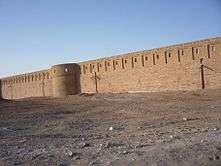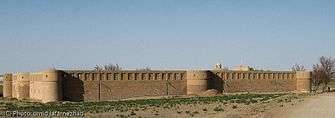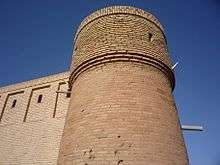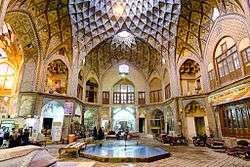Maranjab Caravansarai
The Maranjab Caravansarai is a caravanserai in the Maranjab Desert, located to the north of Aran o Bidgol city in Isfahan province, Iran. It was constructed by order of Shah Abbas in 1603 and located along the Silk Road, between Khorasan and Isfahan provinces.[1]

History

Constructed along the Silk Road in 1603, the caravanserai was used by travelers from China and Europe for many years. It was also used as a fortress, with 500 soldiers to protect travelers against bandits and to fight against possible military attacks from countries to the east, such as Afghanistan and Uzbekistan.[2]
In 2000 Iran's historical heritage association instituted a project to repair the building, which continued until 2004. Since then it has been used as a tourist attraction.[3]
Structure

The 3,500-square-metre (38,000 sq ft) rectangular building has 29 rooms and is totally made of bricks.
The fortified exterior walls have six watchtowers for archers and scout troops.[4]
Tourist attraction
Being in the middle of a desert, the caravanserai attracts numerous desert lovers. The main tourist attractions of the area are off-road driving, astronomy and camel riding.[5]
References
- "کاروانسرای مرنجاب". تیشینه (in Persian). Retrieved 2016-12-31.
- "قلعه مرنجاب". www.irandeserts.com. Retrieved 2016-12-31.
- "کاروانسرای مرنجاب, بنایی در قلب کویر". Aftabir.com. Retrieved 2016-12-31.
- "کاروانسرای مرنجاب, بنایی در قلب کویر". Aftabir.com. Retrieved 2016-12-31.
- "کاروانسرای مرنجاب". www.makanbin.com. Retrieved 2016-12-31.
